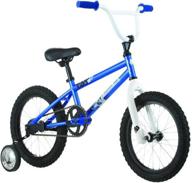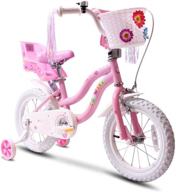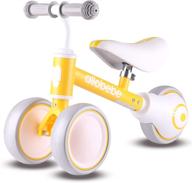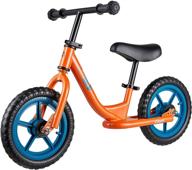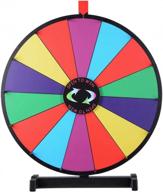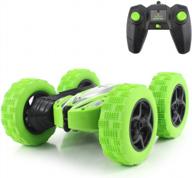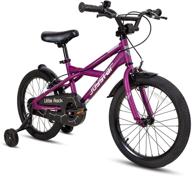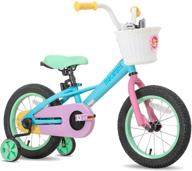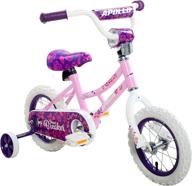Choosing the Right Bike for Your Child's Age and Size
Choosing the right size bike for your child is important for safety and making sure they enjoy riding. The correct bike size allows them to comfortably reach the pedals and handlebars while having control and stability. Consider your child's age, height, inseam length, and motor skills when deciding on wheel size.
Top products in 🚲 Kids' Bikes
Bike Sizes by Age
- Ages 2-4: 12-16 inch wheel bikes
- Ages 4-6: 16-20 inch wheel bikes
- Ages 6-10: 20-24 inch wheel bikes
- Ages 10-14: 24-27 inch wheel bikes
These age ranges are general guidelines. The best way to check is by your child's height and inseam measurements.
Matching Bike Size to Height
| Child's Height | Bike Wheel Size |
|---|---|
| 2'8" - 3'4" | 12" - 16" |
| 3'2" - 3'7" | 16" - 20" |
| 3'6" - 4'4" | 20" - 24" |
| 4'2" - 5'4" | 24" - 27" |
Measure your child's height and match it to the table for a starting point.
The Inseam Method
For the most accurate sizing, measure your child's inseam, which is the length between their crotch and the floor.
- Minimum seat height = 0.49 x inseam length
- Maximum seat height = 0.62 x inseam length
Compare your child's minimum and maximum seat heights to bike seat heights for different wheel sizes.
The inseam method ensures your child can comfortably reach the pedals and the ground while seated.
Motor Skill Readiness
Balance and coordination are also key for bike riding success. Make sure your child has developed the motor skills necessary for pedaling and steering before jumping to a pedal bike.
Training wheels can help transition kids who don't yet have the balance and skills. Going from a balance bike to a pedal bike also builds up their abilities.
With the right sized bike and a little practice, your child will be cruising around in no time!
Comparing Balance Bikes, Pedal Bikes, and Training Wheels
When your child is ready to ditch the tricycle, there are three main options to consider - balance bikes, pedal bikes, and bikes with training wheels. Each has pros and cons to factor in.
Balance Bikes
Balance bikes, also known as runner bikes, are pedal-free with feet-powered motion. Kids sit on the seat and push themselves along with their feet.
- Pros:
- Teaches balance and steering
- Easier transition to pedal bike
- Safer than pedal bikes or trikes
- Can be used at very young ages (18 mos+)
- Cons:
- Higher cost than some pedal bikes
- Limited seating positions
- Can't coast like a pedal bike
Pedal Bikes
Pedal bikes operate by pedaling to propel the bike forward. Variable gearing and coaster brakes are options.
- Pros:
- Allow coasting
- Faster than balance bikes
- Teach pedaling skills
- Cons:
- Require balance proficiency
- Can be too challenging at young ages
- Falls and injuries more likely
Bikes with Training Wheels
Training wheels attach to the rear wheel axle for stability while kids learn to balance.
- Pros:
- Allow pedaling without balance
- Safer than standard pedal bikes
- Can be removed later
- Cons:
- Can inhibit balance skills
- Not adjustable for terrain
- Heavy and awkward for storage/transport
Consider your child's coordination, risk factors, and learning style when deciding which is best.
Safety First - Helmets, Pads, Visibility, and Rules of the Road
Riding a bike is a fun childhood activity, but safety should always come first to prevent injuries. Proper equipment, visibility aids, supervision, and adhering to rules of the road will help keep your child safe while cycling.
Helmets
Helmets are essential for protecting your child's head in the event of a fall or collision. According to a study in the New England Journal of Medicine, helmets reduce the risk of head injury by 85%.
- Look for a CPSC sticker inside the helmet to ensure it meets safety standards.
- Make sure the helmet fits properly and sits level on your child's head.
- Replace any helmet that has been involved in a crash, even if no damage is visible.
Another interesting products
Pads and Protective Gear
Wrist guards, elbow pads, and kneepads will shield against scrapes and fractures. Ankle and shin guards are recommended for trail or mountain biking.
Reflectors and Lights
Reflectors on the bike frame, wheels, pedals, and handlebars make your child much more visible to drivers, especially at dawn, dusk, or night. Headlights and taillights should be used when riding after dark.
Similar products
Adult Supervision
Children under 10 should always be accompanied by an adult when cycling, even on sidewalks or in the neighborhood. An adult can warn about upcoming obstacles and traffic and assist if the child loses control.
Rules of the Road
- Ride single file on the right side of the road.
- Obey all stop signs, traffic lights, and lane markings.
- Use hand signals when turning.
- Yield to pedestrians.
Following the rules of the road and modeling good behavior will help kids become better cyclists as they grow up.
The right gear plus smart riding equals safe cycling for kids. Start teaching bike safety from an early age to instill good habits.
Top Picks for Boys and Girls in Different Age Groups
Finding the right bike for your child involves considering their height, motor skills, and interests. While gender does not dictate preferences, general trends can help narrow the options.
Ages 2-4
Girls
- Radio Flyer Glide & Go Balance Bike - pink model with removable training wheels
- Strider Classic Balance Bike - light 12" model in pink
- Early Rider Lite Balance Bike - 14" wheel lightweight girl's bike
Boys
- Banana Bike LT Balance Bike - lightweight 12" navy model
- Haro Prewheelz Balance Bike - blue 12" bike with footrests
- Strider Sport Balance Bike - 12" in darker color schemes
Ages 4-6
Girls
- Diamondback Mini Viper Kids Bike - 20" wheels with easy reach brake
- Schwinn Koen Girls Bike - 20" wheel bike in pink with basket
- Guardian Kids Bike - lightweight girl's model with training wheels
Boys
- RoyalBaby Freestyle Kids Bike - 20" wheels with front hand brake
- Mongoose Legion Mag BMX Bike - 20" mag wheels for tricks
- Pacifica Kids Mountain Bike - 21-speed 20" navy MTB
Ages 6-10
Girls
- Rhino Luna Kids Bike - 24" 7-speed with linear pull brakes
- Schwinn Streamliner Kids Bike - light step-thru frame in 24"
- GT Stomper Ace 26" Mountain Bike - full suspension 26" MTB
Boys
- Mongoose Ledge 2.1 Boys' Bike - 21-speed 26" trail mountain bike
- Diamondback Octane 24 Youth Bike - 24" with 24 gears
- GT Aggressor Pro BMX Race Bike - lightweight race-ready BMX
Test different bikes to find the best fit and features to match your child's skills and preferences.
Making Learning to Ride Fun and Keeping Your Child Motivated
Learning to ride a bike is a major milestone for kids, but it takes time and practice to build skills and confidence. Making the learning process engaging and keeping your child motivated with encouragement can help them master this activity.
Start with a Balance Bike
Balance bikes allow kids to first get a feel for steering and balancing without the complexity of pedaling. Let your child roll down gentle slopes and race around flat areas trouble-free.
Make Safety Gear Fun
Let your child pick out a helmet with their favorite characters or colors. Stylish kneepads and elbow pads also provide motivation to gear up.
Practice Games & Activities
- Play "follow the leader" - your child can mimic your moves.
- Draw chalk lines or create an obstacle course to ride through.
- For younger kids, hold a fun distracting toy ahead to keep their eyes up.
Try Pedal Pushers
Pedal pushers attach temporarily to the bike's rear wheel for an adult to hold and push. Kids can focus just on steering, braking and balancing.
Use Encouraging Words
Cheer on small successes, remind your child you’re there if they need help, and say you know they can do it. Stay calm and positive.
Take Breaks
Short 5-10 minute practice sessions let your child rest when frustrated. Frequent mini-sessions work better than one long stressful one.
Mix Up Terrain
Try grass, dirt paths, slight slopes or different surfaces. This builds skill better than flat straight pavement.
Add Excitement
Nerf bars on the back let family members "joust." Streamers on the handlebars flutter while riding. A horn or bell can add interactive fun.
End on a High Note
If your child is progressing well, let them end with something easy to build confidence. If they’re struggling, take a break before it gets too difficult.
With your support and engagement, your child will be pedaling independently in no time!
Bike Maintenance Tips - Adjusting Seat Height, Tire Pressure, Cleaning, and Storage
Performing basic bike maintenance will keep your child's bike in safe working order. Check these key areas regularly for a smooth and enjoyable riding experience.
Adjusting Seat Height
As your child grows, the seat height needs adjustment. With feet flat on the ground, there should be 1-2 inches of clearance between the top bar and your child's crotch.
- Loosen seat clamp and raise or lower seat post.
- Re-tighten clamp to secure.
- Have your child straddle the bike to test height.
Tire Pressure
Underinflated tires can lead to flats and make pedaling difficult. Overinflated tires reduce traction and bump absorption.
- Use a bike pump and pressure gauge.
- Inflate to the PSI rating marked on the tire sidewall.
- Check pressure at least once a month.
Cleaning
Dirt and debris will accelerate wear and tear. Clean regularly with soap and water.
- Wipe down frame with a wet cloth.
- Use bristle brush on stubborn dried mud.
- Rinse components with low pressure water.
- Dry thoroughly with a towel to prevent rust.
Lubrication
Apply a lubricating oil like WD-40 to the chain periodically to prevent rust and ensure smooth pedaling.
Storage
Protect your bike from weather damage when not riding. Store it:
- Indoors - place it on a bike hook or stand
- Outdoors - invest in a storage shed or bike cover
Consistent bike maintenance will maximize performance and extend your investment.
How to Get an Amazon Prime Subscription for a Profit When Buying Kids' Bikes
An Amazon Prime subscription can end up saving you money if you use it strategically when shopping for kids' bikes and gear. Here are some tips to maximize the benefits and offset the $139 annual fee.
Take Advantage of Free Shipping
Prime offers free two-day shipping on most items. This perk alone can outweigh the membership cost if you make a lot of purchases. Bikes require expensive special shipping that Prime subs waive. You'd spend $50-100 on bike shipping alone at other retailers.
Buy During Exclusive Prime Days Sales
Prime members get exclusive access to Lightning Deals and major sales on Prime Day events. Look out for big discounts on bikes, helmets, pads, and accessories during these events a few times per year.
Earn 5% Back with the Prime Card
The Amazon Prime Rewards Visa Card offers 5% back on all Amazon purchases for Prime members. That rebate can quickly negate the $139 fee if you spend a few thousand dollars per year.
Take Advantage of Free Content
A Prime subscription includes free access to Prime Video, Music, Kindle ebooks, and more. Make the most of this included entertainment and you can essentially subtract the standalone costs from the $139.
Split the Cost of a Family Subscription
The Amazon Family plan allows two adults and up to four teens to share a Prime membership. At $189 per year, costs can be distributed across several people to make it even more affordable.
Buy Amazon Gift Cards at a Discount
Services like CardCash allow you to purchase discounted Amazon gift cards to save 5-10% off future purchases. Combining gift card deals and Prime perks maximizes savings.
With smart shopping strategies, a Prime subscription can pay for itself quickly when buying bigger-ticket items like kids' bikes. Take full advantage of its benefits to profit from the membership.
What Are The Best Kids' Bikes For Beginners?
When it comes to finding the best kids' bikes for beginners, there are several options to choose from. Here are some of the best bikes for kids who are just starting out:
- Strider 12 Sport Balance Bike: This bike is perfect for kids who are learning to balance and steer. It is lightweight and easy to maneuver, making it a great choice for young riders.
- REI Co-op Cycles REV 16 Kids' Pedal Bike: This bike is designed for kids who are ready to start pedaling. It is lightweight and highly adjustable, making it a great choice for kids who are still growing.
- Royalbaby Freestyle Kids Bike: This bike is a great option for parents who don't want to spend a lot of money on a bike that their child will outgrow quickly. It is durable and easy to ride, making it a great choice for beginners.
- Frog 40 Starter Bike: This lightweight and colorful bike is a great option for younger children who are just starting to ride. It has wide tires and a comfortable ride, making it a great choice for kids who are still learning.
- Strider 12 Sport with Pedals: This bike is perfect for kids who are ready to start pedaling. It has a hand brake and coaster brakes for added safety, and it is lightweight and easy to ride.
- Guardian 20-Inch Kids' Bike: This bike is designed for kids who are ready for a bigger bike. It has a lightweight frame and high-quality components, making it a great choice for kids who are ready to take their riding to the next level.
What Are The Differences Between Balance Bikes And Pedal Bikes For Kids?
Balance bikes and pedal bikes for kids have some key differences. Here are some of the main differences between the two types of bikes:
Balance Bikes:
Pedal Bikes:
Overall, balance bikes are a great choice for young children who are just starting to learn how to ride a bike, while pedal bikes are better for children who have already mastered the basics of balancing and steering.
What Are The Benefits Of Using A Balance Bike For Kids?
Balance bikes are a great way to introduce young children to the joy of bike riding. Here are some of the benefits of using a balance bike for kids:
- They're easy to use: Balance bikes don't have any pedals, so kids only have to focus on one thing - balancing. This makes the learning process a whole lot easier for them.
- They build strength and coordination: The design of a balance bike encourages kids to use their arms and lift their legs when moving forward. This not only helps them to build up their strength, it also helps them to fine-tune their motor skills, coordination, and agility.
- They're a safer way to start riding: The seat of a balance bike is a lot closer to the ground than on a regular bike. If your little one does fall, they won't have far to go. Plus, a balance bike can only go as fast as your child can push, which means you won't have to worry about any high-speed crashes.
- They make exercise fun: Balance bikes take the hard work out of teaching your child how to ride. Once your child has learned how to balance, they'll soon be able to move up to a regular bike without the need for training wheels.
- They give kids more control: Because their feet are still on the ground, kids are introduced to the world of cycling with the benefit of stability. Balance bikes are designed to make little ones feel safe and secure while easing them into riding.
- They boost development: Balance bikes help kids practice motor planning, understand spatial awareness, and activate the vestibular system. Building leg strength can also help with other milestones like climbing stairs and walking backward.







